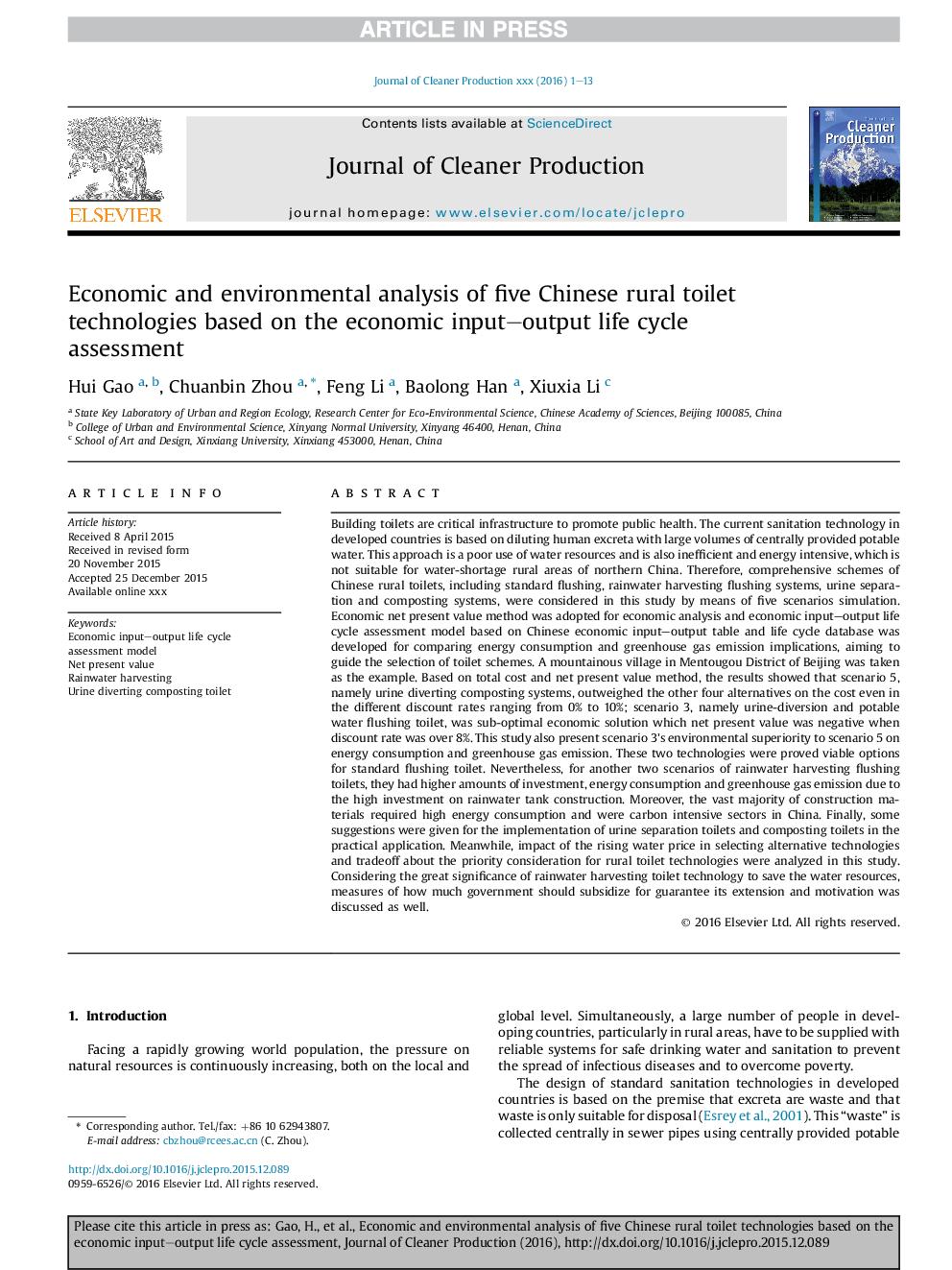| کد مقاله | کد نشریه | سال انتشار | مقاله انگلیسی | نسخه تمام متن |
|---|---|---|---|---|
| 5480556 | 1399317 | 2017 | 13 صفحه PDF | دانلود رایگان |
عنوان انگلیسی مقاله ISI
Economic and environmental analysis of five Chinese rural toilet technologies based on the economic input-output life cycle assessment
ترجمه فارسی عنوان
تجزیه و تحلیل اقتصادی و زیست محیطی پنج تکنولوژی بهداشت روستایی چین براساس ارزیابی چرخه حیات ورودی-خروجی اقتصادی
دانلود مقاله + سفارش ترجمه
دانلود مقاله ISI انگلیسی
رایگان برای ایرانیان
کلمات کلیدی
مدل ارزیابی چرخه عمر ورودی-خروجی اقتصادی، ارزش خالص فعلی، برداشت آب باران، ادرار توالت کمپوست،
موضوعات مرتبط
مهندسی و علوم پایه
مهندسی انرژی
انرژی های تجدید پذیر، توسعه پایدار و محیط زیست
چکیده انگلیسی
Building toilets are critical infrastructure to promote public health. The current sanitation technology in developed countries is based on diluting human excreta with large volumes of centrally provided potable water. This approach is a poor use of water resources and is also inefficient and energy intensive, which is not suitable for water-shortage rural areas of northern China. Therefore, comprehensive schemes of Chinese rural toilets, including standard flushing, rainwater harvesting flushing systems, urine separation and composting systems, were considered in this study by means of five scenarios simulation. Economic net present value method was adopted for economic analysis and economic input-output life cycle assessment model based on Chinese economic input-output table and life cycle database was developed for comparing energy consumption and greenhouse gas emission implications, aiming to guide the selection of toilet schemes. A mountainous village in Mentougou District of Beijing was taken as the example. Based on total cost and net present value method, the results showed that scenario 5, namely urine diverting composting systems, outweighed the other four alternatives on the cost even in the different discount rates ranging from 0% to 10%; scenario 3, namely urine-diversion and potable water flushing toilet, was sub-optimal economic solution which net present value was negative when discount rate was over 8%. This study also present scenario 3's environmental superiority to scenario 5 on energy consumption and greenhouse gas emission. These two technologies were proved viable options for standard flushing toilet. Nevertheless, for another two scenarios of rainwater harvesting flushing toilets, they had higher amounts of investment, energy consumption and greenhouse gas emission due to the high investment on rainwater tank construction. Moreover, the vast majority of construction materials required high energy consumption and were carbon intensive sectors in China. Finally, some suggestions were given for the implementation of urine separation toilets and composting toilets in the practical application. Meanwhile, impact of the rising water price in selecting alternative technologies and tradeoff about the priority consideration for rural toilet technologies were analyzed in this study. Considering the great significance of rainwater harvesting toilet technology to save the water resources, measures of how much government should subsidize for guarantee its extension and motivation was discussed as well.
ناشر
Database: Elsevier - ScienceDirect (ساینس دایرکت)
Journal: Journal of Cleaner Production - Volume 163, Supplement, 1 October 2017, Pages S379-S391
Journal: Journal of Cleaner Production - Volume 163, Supplement, 1 October 2017, Pages S379-S391
نویسندگان
Hui Gao, Chuanbin Zhou, Feng Li, Baolong Han, Xiuxia Li,
